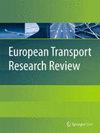老龄化社会的人口密度与机动车撞伤严重程度的影响:西班牙案例
IF 4.2
3区 工程技术
Q1 TRANSPORTATION
引用次数: 0
摘要
城市人口的集中和农村人口的减少,再加上一代人向老龄化社会的转变,给道路安全带来了新的挑战。在此,我们根据车祸发生地的人口密度、驾驶员的年龄及其居住地的人口密度,研究了车祸中机动车乘员所受伤害的严重程度。西班牙是欧洲农村地区老年人口最集中的国家之一,我们在该国开展了这项研究。我们使用关系方法将欧洲统计局的城市化分类与西班牙交通总局的事故数据库进行匹配,从而将每起事故与事故发生地的人口密度联系起来。为了分析人口密度与肇事车辆乘员身体伤害严重程度之间的关系,我们拟合了一组具有随机效应的广义线性模型,以衡量驾驶员搬迁和地理区域老化的影响。在 5%的显著性水平上,拒绝了伤害严重程度与城市化程度的独立性。西班牙有 53.8%的人口居住在人口稠密地区,只有 13.5%的人口居住在农村地区,而农村地区却集中了最多的车祸死亡人数:是城市地区的 2.3 倍(分别为 43.5%和 18.6%)。居住在农村地区的驾驶员在城市和中间地区发生交通事故时,更有可能受到严重或致命的伤害。此外,75 岁以上的驾驶员更有可能受到严重或致命伤害,尤其是在城市地区发生碰撞事故时。最近的研究提醒人们注意将公共服务(尤其是医疗保健)集中在人口稠密地区对农村居民(通常是老年人)的影响。我们的研究表明,在人口较密集地区发生的车祸也是一个农村健康问题。政策决策者需要解决这一问题,以减少受害者的人数及其身体伤害的严重程度。本文章由计算机程序翻译,如有差异,请以英文原文为准。
Effect of population density in aging societies and severity of motor vehicle crash injuries: the case of Spain
The concentration of population in cities and processes of rural depopulation coupled with the generational shift to older societies represent new challenges in road safety. Here, we examine the severity of injuries suffered by the occupants of motor vehicles involved in a crash based on the population density of the area in which the crash occurs, the driver’s age and the density of their place of residence. We conduct the study in Spain, a country with one of the highest levels of elderly population concentrated in rural areas in Europe. Relational methods are used to match Eurostat’s urbanization classifications with the accident database of Spain’s Directorate General of Traffic so as to correlate each crash with the population density of the place where it occurred. A set of generalized linear models with random effects is fitted to analyze the relationship between population density and the bodily injury severity of the occupants of the vehicle(s) involved in a crash, measuring the effect of drivers’ relocation and aging by geographical area. Independence of injury severity and the degree of urbanization was rejected at the 5% significance level. While 53.8% of the Spanish population is living in densely populated areas and only 13.5% in rural areas, the latter concentrates most crashes with fatalities: 2.3 times more than in urban areas (43.5 and 18.6%, respectively). Drivers living in rural areas are more likely to be associated with serious or fatal injuries when involved in a crash in urban and intermediate areas. Moreover, drivers aged over 75 are significantly more likely to be associated with serious and fatal injuries, especially when the crash occurred in urban areas. Recent research alerts on the implications for rural (often elderly) residents of concentrating public services, particularly healthcare, in densely populated areas. Our study shows that motor crashes in more densely populated areas are also a rural health concern. Policy decision-makers need to address this issue to reduce the number of victims and their bodily injury severity.
求助全文
通过发布文献求助,成功后即可免费获取论文全文。
去求助
来源期刊

European Transport Research Review
Engineering-Mechanical Engineering
CiteScore
8.60
自引率
4.70%
发文量
49
审稿时长
13 weeks
期刊介绍:
European Transport Research Review (ETRR) is a peer-reviewed open access journal publishing original high-quality scholarly research and developments in areas related to transportation science, technologies, policy and practice. Established in 2008 by the European Conference of Transport Research Institutes (ECTRI), the Journal provides researchers and practitioners around the world with an authoritative forum for the dissemination and critical discussion of new ideas and methodologies that originate in, or are of special interest to, the European transport research community. The journal is unique in its field, as it covers all modes of transport and addresses both the engineering and the social science perspective, offering a truly multidisciplinary platform for researchers, practitioners, engineers and policymakers. ETRR is aimed at a readership including researchers, practitioners in the design and operation of transportation systems, and policymakers at the international, national, regional and local levels.
 求助内容:
求助内容: 应助结果提醒方式:
应助结果提醒方式:


